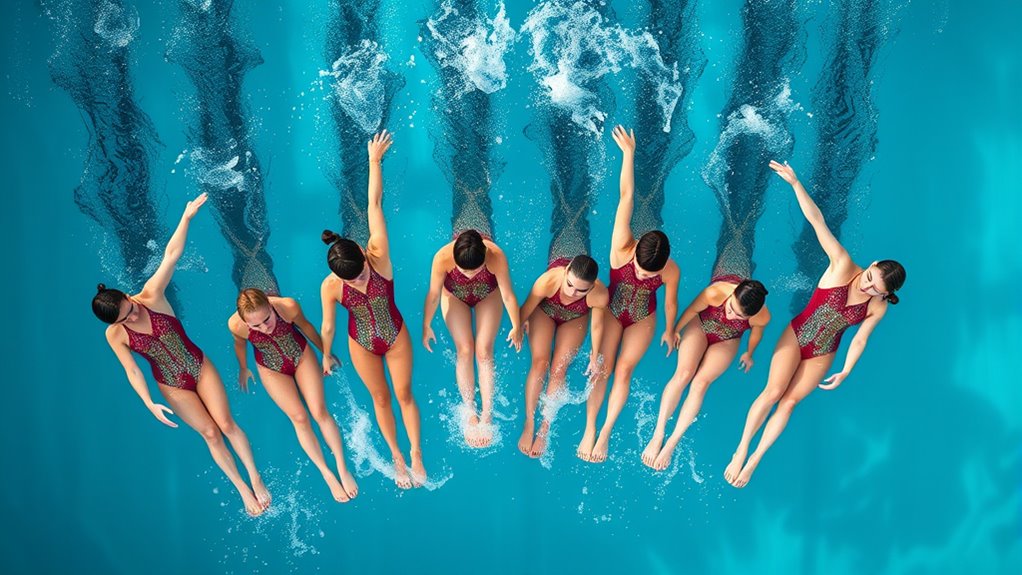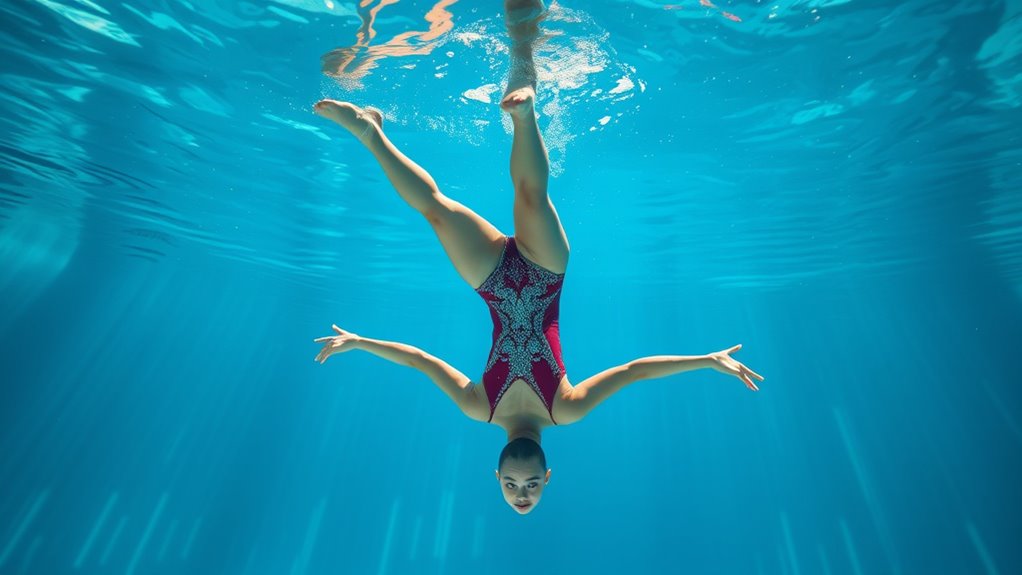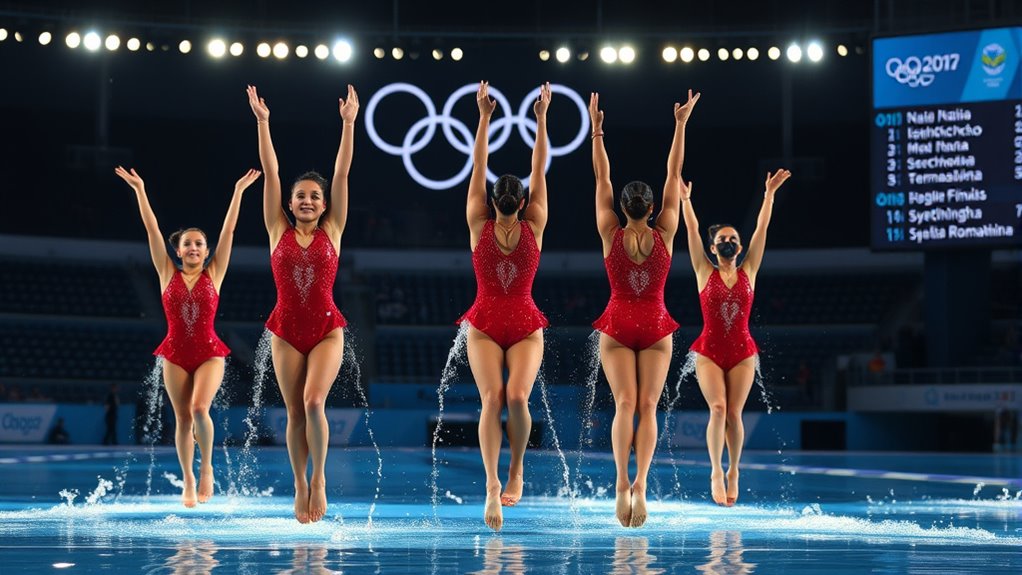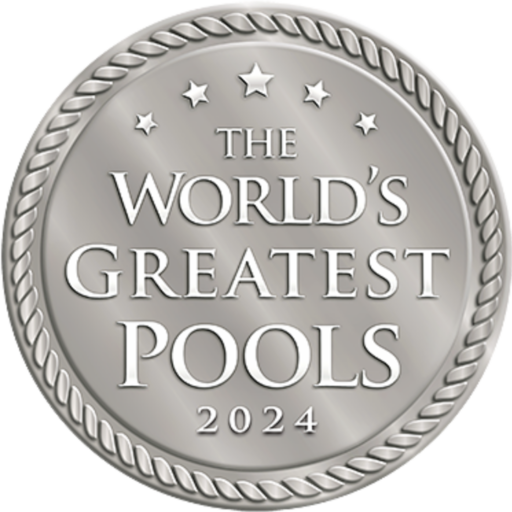Artistic swimming demands mastery of breath control, eggbeater kicks, and sculling techniques while executing synchronized movements to music. You’ll find competitors training 8-10 hours daily, developing flexibility, strength, and mental resilience for both technical and free routines. Judges evaluate performances on technical merit and artistic impression across solo, duet, and team events. The sport has evolved from “synchronized swimming” to reflect its athletic demands, with increasing male participation reshaping traditional gender boundaries.
The Evolution From Synchronized to Artistic Swimming

Though many still refer to it by its former name, synchronized swimming officially became “artistic swimming” in 2017 when FINA (Fédération Internationale de Natation) approved the rebranding to better reflect the sport’s athletic demands. This nomenclature shift represented more than semantics—it acknowledged the discipline’s evolution from its synchronized origins in the early 20th century water ballets.
You’ll notice the artistic transformation has coincided with increasing technical difficulty. Modern routines now incorporate more acrobatic elements, complex hybrids, and higher throws, requiring athletes to possess exceptional strength, flexibility, and breath control. The judging criteria adapted accordingly, with technical merit now weighted on par with artistic impression. This evolution aligns the sport with gymnastics and figure skating, emphasizing both technical precision and creative expression.
Essential Skills and Techniques for Artistic Swimmers
Because artistic swimming demands extraordinary multidimensional abilities, athletes must master several foundational skills before attempting complex routines. You’ll need to develop exceptional breath control through specialized breathing techniques that enable underwater sequences lasting up to 45 seconds while maintaining precise movements and positioning.
The extraordinary demands of artistic swimming require mastering foundational skills before tackling complex routines, including exceptional breath control for underwater sequences.
- Eggbeater kick mastery – This water treading technique provides stability and height while keeping your arms free for choreography
- Sculling proficiency – Diverse hand movements that generate propulsion in multiple directions
- Body control – Maintaining perfect alignment and extension throughout shifts
Flexibility training constitutes a critical component of your development, requiring daily stretching regimens focused on shoulders, hips, and spine. Without this foundation, you’ll struggle to achieve the extreme positions that distinguish elite performances from amateur attempts.
Training Regimens: Behind the Elegant Performance

While spectators marvel at the seemingly effortless performances in competition, artistic swimmers endure grueling training schedules that typically span 8-10 hours daily, six days per week.
You’ll find their regimen divides into distinct components: four hours of water training focusing on technical elements and routine synchronization, followed by two hours of land exercises for strength and flexibility. Advanced training techniques incorporate underwater heart rate monitoring and video performance analysis to optimize breath control and precision.
Cross-training elements include ballet for extension, gymnastics for spatial awareness, and resistance training for the explosive power needed in lifts and throws. Recovery protocols are similarly rigorous, with mandatory contrast therapy and nutritional timing designed to sustain energy through multiple run-throughs of routines at competition intensity.
Competition Structure and Judging Criteria
When examining artistic swimming competitions, you’ll encounter a hierarchical structure that progresses from local meets to the Olympic Games, with distinct formats at each level. Competition formats vary considerably, with events categorized as technical routines, free routines, or combination performances. Judging panels typically consist of 5-7 certified officials who evaluate performances using specific criteria:
Artistic swimming competitions unfold in a tiered structure, featuring diverse formats from technical routines to combination performances evaluated by expert judges.
- Technical merit – precision of movements, synchronization, difficulty level
- Artistic impression – choreography, interpretation of music, manner of presentation
- Execution elements – height of lifts, stability in positions, controlled shifts
You’ll find that scoring follows a 0-10 scale with decimal precision. International competitions require separate technical and free routines, while domestic events might combine elements to accommodate developmental progression through the sport’s competitive pathway.
Olympic History and Notable Champions

Artistic swimming’s Olympic expedition began as a demonstration event at the 1948 London Games before officially joining the Olympic program in 1984 as synchronized swimming. You’ll notice a clear dominance pattern since its introduction, with Russia/Soviet Union capturing 14 golds and the United States establishing early supremacy with consecutive victories in the solo and duet events. The competition structure has evolved notably, shifting from individual events to team competitions, with the mixed duet gaining international prominence though still awaiting Olympic inclusion.
Olympic Timeline and Evolution
Since making its Olympic debut as a demonstration event at the 1952 Helsinki Games, artistic swimming has undergone remarkable transformation in both technical requirements and competitive structure. You can trace its artistic history through pivotal Olympic milestones that revolutionized the sport:
- 1984 Los Angeles Games – Official Olympic status granted with solo and duet competitions, elevating synchronized origins to full recognition
- 1996 Atlanta Olympics – Introduction of team event (8 swimmers), replacing solo and duet formats
- 2020 Tokyo Olympics – Reintroduction of duet competition alongside team events, with improved technical scoring criteria focusing on height, extension, and synchronization
The judging system has evolved from subjective artistic impression to today’s precise technical assessment combining difficulty values and execution scores.
Medal-Winning Nations Dominance
The evolution of Olympic artistic swimming‘s competitive structure has shaped distinct patterns of national dominance throughout its history. Russia’s overwhelming control of the medal podium (post-1996) stands unmatched, with their technical precision establishing a near-monopoly in team and duet events.
You’ll notice three distinct periods in medal distribution: the American dominance (1984-1992), the Russian ascendancy (1996-present), and Japan’s consistent bronze-level performances. While Canada periodically challenges this hierarchy, they’ve struggled to displace the established powers.
Historical performance metrics reveal fascinating specialization patterns—the U.S. excelled in solo competitions, while Russia revolutionized team synchronization standards. Spain and China have emerged as potential disruptors, gradually improving their technical execution scores and artistic impression ratings to challenge the established medal hierarchy.
The Technical vs. Free Routine: Understanding the Differences
Within the competitive framework of artistic swimming, technical and free routines represent two distinct performance categories that judges evaluate using different criteria. Technical routines require specific, predetermined elements executed with precise timing and synchronization, focusing primarily on technical elements rather than thematic development.
Technical routines demand predetermined elements with precision, prioritizing execution over thematic expression in artistic swimming competitions.
Free routines, conversely, showcase the swimmers’ artistic expression and creativity without prescribed movements, allowing teams to construct narratives through choreography.
The key distinctions include:
- Required Elements – Technical routines mandate specific figures, while free routines permit unlimited creativity
- Judging Focus – Technical scoring emphasizes execution accuracy; free routines prioritize artistic impression
- Time Constraints – Technical routines typically run shorter than their free counterparts, demanding concentrated precision
You’ll notice elite competitors display mastery in both disciplines, adapting their strategies to enhance scoring potential in each format.
Team Dynamics and Choreography Development
Effective team dynamics in artistic swimming begin with trust relationships that you’ll cultivate through consistent training partnerships and vulnerability during high-risk elements. You’re establishing choreographic cohesion through micro-synchronization techniques—breath timing, muscle tension matching, and proprioceptive awareness—that transform eight individuals into a single visual entity. When developing unified movements, you’ll progress from basic pattern formations to complex shifts, ensuring each swimmer internalizes not just their position but the complete spatial architecture of the routine.
Cohesion Through Trust
Trust forms the foundation of every successful artistic swimming team, binding athletes together through invisible yet powerful connections that manifest visibly in performance. You’ll notice elite teams engage in deliberate trust-building exercises both in and out of water to cultivate the psychological safety necessary for complex movements.
Team synergy emerges through:
- Vulnerability practice – allowing teammates to support your full body weight during lifts and throws
- Consistent feedback loops – developing communication systems that enable real-time adjustments underwater
- Shared responsibility – embracing collective accountability for synchronization rather than individual perfection
When you’ve established deep trust, athletes execute riskier elements with confidence, knowing their teammates will maintain proper positioning. This psychological cohesion translates directly to technical precision, creating that seamless unison judges reward with higher scores.
Crafting Unified Movements
The psychological foundation of trust manifests physically through precisely crafted choreography that transforms individual swimmers into a single, breathing organism. You’ll observe this metamorphosis during the critical eight-week pre-competition phase when teams develop their technical routines.
Synchronized movements evolve through a multi-layered approach: initially establishing count structures (typically 8-count patterns), then building shift frameworks before adding artistic expression elements. You’re developing what coaches call “muscle memory dialogue”—the nonverbal communication system enabling eight athletes to respond simultaneously to environmental variables.
Elite teams incorporate proprioceptive training, using blindfolded drills to heighten spatial awareness between swimmers. This heightened sensitivity creates the millisecond-level precision distinguishing world-class performances. The most successful choreographers utilize each athlete’s strengths while minimizing individual tendencies that disrupt the collective visual harmony.
Equipment and Attire in Artistic Swimming
Precise costuming and specialized equipment form the foundation of competitive artistic swimming, extending far beyond mere aesthetics to serve essential functional purposes. Technical swim caps, typically made of silicone, maintain hair position during underwater sequences while reducing drag—an essential performance consideration when synchronization matters to the millisecond.
In artistic swimming, every equipment choice balances function with form—where milliseconds and millimeters determine championship outcomes.
Performance makeup applications follow strict technical protocols:
- Waterproof formulations with theatrical-grade pigmentation
- Strategic contouring techniques enhancing facial visibility at distance
- Gelatin-based setting methods ensuring chlorine resistance
You’ll find nose clips indispensable for extended inverted positions, while custom swimsuits incorporate specialized fabric technologies balancing flexibility with compression. Competition regulations dictate precise parameters for all attire elements, requiring athletes to optimize their equipment choices within strict technical boundaries that balance artistic expression with functional performance requirements.
Physical and Mental Demands of the Sport
While specially designed equipment enables artistic swimmers to perform, understanding the sport’s extraordinary physiological and psychological requirements reveals why it ranks among athletics’ most demanding disciplines. You’ll need exceptional breath control, maintaining complex choreography while performing underwater for extended periods—often 40-45 seconds without breathing.
Strength training forms the cornerstone of preparation, developing the powerful core and leg muscles needed for explosive movements and sustained inverted positions. Your cardiovascular system must function efficiently underwater where heart rates typically reach 170+ BPM during routines.
Mental resilience distinguishes elite performers from novices. You’ll master spatial awareness while disoriented, memorize intricate routines synchronized to millisecond precision, and maintain composure despite extreme physical exertion—all while presenting an appearance of effortlessness under judges’ scrutiny.
Male Participation and the Future of Artistic Swimming
Although historically perceived as a female-exclusive discipline, artistic swimming has undergone significant gender paradigm shifts since 2015, when FINA (now World Aquatics) initially permitted male competitors in mixed duets at world championships. This male inclusion represents a pivotal evolution in the sport’s trajectory, with participation numbers gradually increasing at elite levels.
The integration of male athletes into artistic swimming marks a watershed moment in dismantling gender conventions within aquatic sports.
Future opportunities in artistic swimming will likely develop through:
- Olympic inclusion of mixed duets, potentially by Los Angeles 2028
- Restructured scoring systems acknowledging physiological differences in male performers
- Development of male-specific technical elements leveraging distinct strength advantages
You’ll notice competitive dynamics evolving as gender barriers dissolve, with nations like Russia, China, and the United States strategically incorporating male athletes into their development pipelines to enhance medal potential.
Frequently Asked Questions
How Old Should Children Be When Starting Artistic Swimming?
You’ll find children typically start artistic swimming between stages 6-9, when they’ve mastered basic swimming skills. Most beginner classes accept 7-year-olds who can swim confidently without assistance. This entry point allows young athletes to develop core strength and breath control before addressing complex movements. Coaches prefer this stage range as it strikes the ideal balance between developmental readiness and neuroplasticity – early enough for skill acquisition but mature enough to follow technical instructions.
Can Artistic Swimmers Hear Music Underwater During Routines?
You can’t hear music clearly underwater due to complex underwater acoustics. As a performer, you’ll rely primarily on visual cues from teammates and muffled bass vibrations rather than distinct melodies. You’ll practice synchronized rhythms extensively on land until your body internalizes the timing. Many elite swimmers count beats mentally during routines. Some competitions use underwater speakers, but they provide limited audio quality—you’ll ultimately depend on muscle memory and practiced timing rather than auditory guidance.
What’s the Average Career Length for Elite Artistic Swimmers?
Elite artistic swimmers typically sustain careers of 8-12 years, though you’ll find significant variation based on training intensity and physiological factors. Peak performance generally occurs between stages of 18-25, when technical precision aligns with ideal strength-to-weight ratios. Your longevity depends on injury management, coaching quality, and funding security. Many athletes experience diminishing returns after multiple Olympic cycles due to the sport’s extreme physical demands and the metabolic efficiency decline that accompanies growing older.
How Do Swimmers Keep Their Makeup Intact Underwater?
You’ll need specialized waterproof products to maintain makeup integrity underwater. Apply a silicone-based primer initially, then layer with alcohol-activated makeup techniques that create a seal against moisture. Set everything with translucent powder before applying a makeup setting spray containing alcohol. Professional artistic swimmers often use theatrical-grade products with improved adhesion properties, applying in thin layers rather than single thick applications to prevent cracking during performances.
Are There Scholarships Available for Collegiate Artistic Swimming?
You’ll find limited scholarship opportunities for collegiate artistic swimming compared to mainstream sports. NCAA classifies it as an “emerging sport,” with only about 20 US colleges offering programs. Partial scholarships are more common than full-rides. For college recruitment, build relationships with coaches early, create impressive highlight videos showcasing technical elements, and maintain strong academics. Stanford, Ohio State, and Florida offer some of the most established programs with potential funding for exceptional athletes demonstrating both artistic and athletic prowess.



